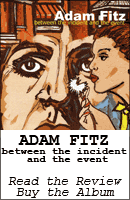2xLP: Steve Reid Ensemble - Spirit Walk
 Artist: Steve Reid Ensemble
Artist: Steve Reid EnsembleAlbum: Spirit Walk
Label: Soul Jazz
List Price: $25.49
Released: November 2005
Review: In an interview with Mike Barnes in the February, 2006 issue of The Wire, 62 year-old drummer Steve Reid had this to say about the state of modern jazz music:
"I always stay with people younger than me, because my generation's retired, man... you're sitting at home listening to your custom CDs, special editions. So I need some people who are out there with me, you know? So that's why I go with the youth, man. It's always about the youth - keep the shit fired up."
Reid, who has played with such music visionaries as Sun Ra, James Brown, Miles Davis, Fela Kuti, Ornette Coleman and more, knows a thing or two about keeping the "shit fired up." A tireless touring musician, Reid got his start in high school when Motown's Martha and the Vandellas performed and needed a replacement for their drummer who was snowed in in Detroit. Reid sat in, recorded the song "Heat Wave" with the group and hasn't looked back since. By the time he was twenty, Reid was playing in Fela Kuti's Africa 70 in Nigeria where he learned the art of improvisation and environmental adjustment.
With the release of 2005's Spirit Walk, Reid is garnering a long deserved fame outside of the jazz sphere. In keeping with his desire to work with the young people, few, if any of the other musicians on this album are over the age of 30. Most notably and surprisingly, is Kieran Hebden (aka Four Tet), the laptop noise musician known more in the electronic music scene than among the folks who have a copy of Love Supreme and Kind of Blue on their shelves. Hebden and Reid's pairing results in an album that ranges from tightly orchestrated jazz and funk grooves to cacophonous free jazz freak outs that only come from musicians who have mastered their craft.
At its most extreme, Spirit Walk approaches sound collage. The album's second track, "Drum Story," is a duet between Reid on drum and Hebden on electronic squelches. Free of almost any structure, this fourteen minute long song features at least seven different alternating rhythms, digital noise pulled to its extreme and a frenetic monologue by Reid himself, pontificating about the power of rhythm and the apolitical importance of music. At the other end of the spectrum lies the track, "For Coltrane," which is a sax-driven number featuring a bold organ backup, a steady beat and only the most essential electronic accompaniment to remind the listener that this is nothinglike they have heard before. Having spent a lot of time with Coltrane as a young man (though never recording with him), Reid's homage does more justice than any variation on one of Trane's song could ever achieve. Reid and co. capture several of the late horn player's periods inside of a song only eight minutes long. An impressive feat for such a young group of musicians, who will hopefully take copious notes from Reid's own visionariness.
At seventy minutes long, this double LP frames itself between two strong numbers, beginning with the mildly frenetic "Lugano" which begins with the sound drums would make if they could clear their throats. From there through the last track, "Unity," the instruments on this recording come through loud and clear. At nine minutes, the last cut lets each musician on the album have their time in the spotlight, proving that, regardless of his experience and talent, Reid is an astute listener as well as performer. Collaboration and improvisation are his strengths, and knowing when to let the other players scream only highlights his amazing talents.
British record label, Soul Jazz, is known more for their historical compilations, but their modern releases should not be overlooked. Spirit Walk is proof that archiving and the study of music only sharpens your sense of what music will stand the test of time. Steve Reid is well on his way to being a household name like the greats he has worked with in the past.
Rating: 4.5 / 5
Buy Spirit Walk on CD from Amazon.com: Consume.
Image from Amazon.com












